 W
WAcromyrmex octospinosus is a species of New World ants of the subfamily Myrmicinae of the genus Acromyrmex. It is found in the wild naturally in Central America ranging from southern Mexico down to Panama; and across northern South America in Venezuela.
 W
WApis cerana, the eastern honey bee, Asiatic honey bee or Asian honey bee, is a species of honey bee native to southern, southeastern, and eastern Asia. This species is the sister species of Apis koschevnikovi and both are in the same subgenus as the western (European) honey bee, Apis mellifera. A. cerana is known to live sympatrically along with Apis koschevnikovi within the same geographic location. Apis cerana colonies are known for building nests consisting of multiple combs in cavities containing a small entrance, presumably for defense against invasion by individuals of another nest. The diet of this honey bee species consists mostly of pollen and nectar, or honey. Moreover, Apis cerana is known for its highly social behavior, reflective of its classification as a type of honey bee.
 W
WApis dorsata, the giant honey bee, is a honey bee of South and Southeast Asia, found mainly in forested areas such as the Terai of Nepal. They are typically around 17–20 mm (0.7–0.8 in) long. Nests are mainly built in exposed places far off the ground, like on tree limbs, under cliff overhangs, and sometimes on buildings. These social bees are known for their aggressive defense strategies and vicious behavior when disturbed. Though not domesticating it, indigenous peoples have traditionally used this species as a source of honey and beeswax, a practice known as honey hunting.
 W
WAtractomorpha crenulata, commonly known as the tobacco grasshopper, is a species of grasshopper in the subfamily Pyrgomorphinae, found in Asia.
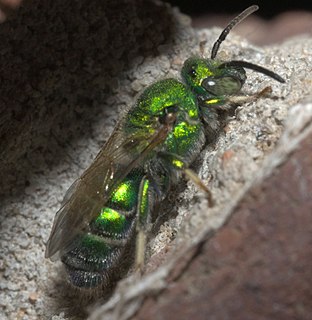 W
WAugochloropsis metallica is a species of sweat bee in the family Halictidae.
 W
WBembix americana is a species of sand wasp in the family Crabronidae. It is found in the Caribbean Sea, Central America, North America, and South America.
 W
WBombus lapponicus is a species of bumblebee. It is native to northern Europe, where it occurs in Finland, Norway, Sweden, and Russia.
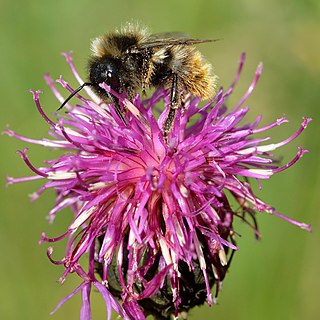 W
WBombus rupestris is a species of cuckoo bumblebee present in most of Europe except Iceland. In the Balkans it is found in montane and alpine habitats northwards from Central Greece. It is also found in Turkey.
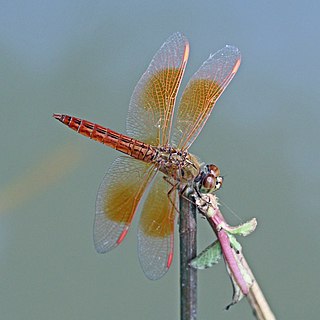 W
WBrachythemis contaminata, ditch jewel, is a species of dragonfly in the family Libellulidae. It is found in many Asian countries.
 W
WCamponotus sexguttatus is a species of ant in the family Formicidae.
 W
WConocephalus fuscus, the long-winged conehead, is a member of the family Tettigoniidae, the bush-crickets and is distributed through much of Europe and temperate Asia. This bush-cricket is native to the British Isles where it may confused with the short-winged conehead. These two species are phenotypically similar; however, the distinguishing factor between the two is the fully developed set of wings the long-winged conehead possesses that allows for flight. In the short-winged coneheads the hind wings are shorter than the abdomen, causing the wings to be vestigial and the species is incapable of flight. For this reason it is hard to discriminate between the two species during the early stages of their life cycle before the wings have fully developed. The colouration of the conehead is typically a grass green with a distinctive brown stripe down its back, though there are some brown phenotypes.
 W
WCrossocerus quadrimaculatus is a Palearctic species of solitary wasp.
 W
WCryptocheilus discolor is a species of pepsid spider wasp which is found in the Mediterranean Basin and the Middle East.
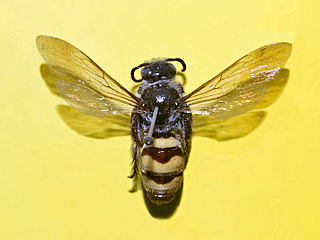 W
WDielis trifasciata is a species of the family Scoliidae.
 W
WDiplacodes nebulosa is a species of dragonfly in the family Libellulidae. It is a widely distributed species in many Asian countries. and northern Australia.
 W
WDolichovespula saxonica, also known as the Saxon wasp, is a common social wasp found in the palearctic region, specifically in large parts of Europe and in northern and central Asia. Although originally from continental Europe, D. saxonica has since colonised Britain, mainly in the south and east, but has been recorded as far north as East Lothian, Scotland. Most of their nests are above ground in trees and bushes, but they can also be found in buildings. Due to the proliferation of nests in urban areas and near residential homes, D. saxonica can be a pest for people. As a result, many human interventions are in place to remove Saxon nests. D. saxonica has been found to use chemical signaling in a lot of behaviours, such as alarm calls, fertility cues, and chemical trails.
 W
WFormica rufibarbis is a European formicine ant of the Formica fusca group. In the classification by Auguste Forel, it is treated in the subgenus Serviformica. F. rufibarbis is subject to a Species Action Plan (SAP) in England, where it is known from only two locations, although it is not considered to be at risk on continental Europe.
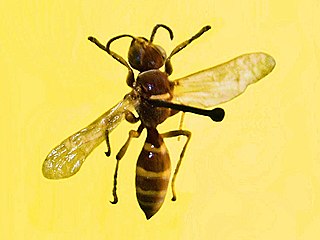 W
WGorytes quinquecinctus is a species of sand wasps belonging to the family Crabronidae.
 W
WThe great blue skimmer is a dragonfly of the skimmer family. With a total length of 50 to 63 mm, it is one of the largest skimmers. The immature forms of the skimmer are brown in color and mature forms are blue-hued. This species is found near lakes, ponds, and slow streams in the eastern United States and rarely in southern Ontario.
 W
WThe horse guard wasp is a type of sand wasp (Bembicini) from the eastern United States which preys primarily upon horse-flies (Tabanidae). It is a large, colorful, fast-flying wasp, one of 28 species in the genus Stictia, all of which have similar biology.
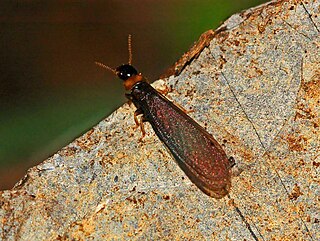 W
WKalotermes flavicollis, the yellownecked dry-wood termite, is a species of dampwood termites belonging to the family Kalotermitidae, one of the most primitive families of termites.
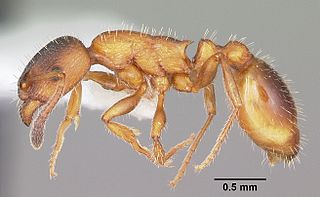 W
WLeptothorax acervorum is a small brown to yellow ant in the subfamily Myrmicinae. It was first described by Johan Christian Fabricius in 1793. L. acervorum is vastly distributed across the globe, most commonly found in the coniferous forests of Central, Western and Northern Europe. The morphology of L. acervorum is extremely similar to that of other Leptothorax ants. The difference arises in the two-toned appearance of L. acervorum, with the head and metasoma being darker than the mesosoma segment of the body, and hair across its body. Following Bergmann's rule—unusually, for ectothermic animals—body size increases with latitude.
 W
WLindenius albilabris is a Palearctic species of solitary wasp from the Crabronidae.
 W
WMicromus variegatus is a species of brown lacewing in the family Hemerobiidae. It is found in Europe & Northern Asia and North America.
 W
WThe Red Grasshawk, also known as Common Parasol, and Grasshawk dragonfly, is a species of dragonfly in the family Libellulidae. It is widespread in many Asian countries.
 W
WNomada rufipes is a Palearctic species of nomad bee.
 W
WNomada striata is a Palearctic species of nomad bee.
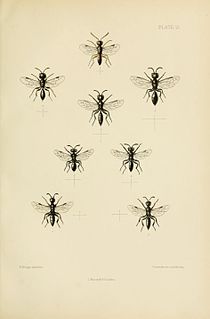 W
WPemphredon lugubris is a Palearctic species of solitary wasp.
 W
WPheidole megacephala is a species of ant in the family Formicidae. It is commonly known as the big-headed ant in the USA and the coastal brown ant in Australia. It is a very successful invasive species and is considered a danger to native ants in Australia and other places. It has been nominated as one of the hundred "World's worst" invaders.
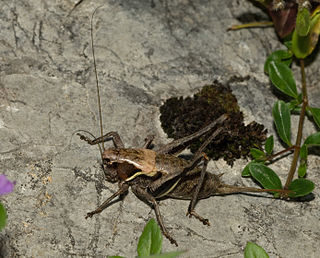 W
WThe alpine dark bush-cricket is a species of cricket belonging to the subfamily Tettigoniinae. It is found in Eastern and Central Europe in the Alps and the Alpine foothills. In Switzerland, their presence limited to the eastern Alps, the Southern Alps and the Schaffhauser Randen. In Germany it occurs south of the line Bodensee, to southern Munich. It also occurs in Austria and Slovenia. It is found at altitudes from 260 to 2360 meters above sea level in densely forested clearings or clearcuts, high-altitude orchards, bracken slopes, rocky, dwarf shrub communities and areas densely populated with grasses and herbaceous plants. At high altitudes, warm southern slopes are preferred.
 W
WPolistes chinensis is a polistine vespid wasp in the cosmopolitan genus Polistes, and is commonly known as the Asian, Chinese or Japanese paper wasp. It is found in East Asia, in particular China and Japan. The subspecies P. chinensis antennalis is an invasive species in New Zealand, having arrived in 1979.
 W
WPolistes fuscatus, whose common name is the golden or northern paper wasp, is widely found throughout southern Canada, the United States, Mexico, and Central America. It often nests around human development. However, it greatly prefers areas in which wood is readily available for use as nest material, therefore they are also found near and in woodlands and savannas. P. fuscatus is a social wasp that is part of a complex society based around a single dominant queen along with other cofoundresses and a dominance hierarchy.
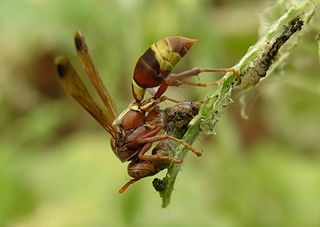 W
WPolistes stigma is a species of paper wasp from Southeast Asia.
 W
WPolystoechotes punctata is a species of giant lacewing in the family Ithonidae. It is found in Central America and North America.
 W
WThe Sahara Desert ant is a desert-dwelling ant of the genus Cataglyphis. It primarily inhabits the Sahara Desert and is one of the most heat tolerant animals known to date. However, there are at least four other species of Cataglyphis living in the Sahara desert, for example C. bombycina, Cataglyphis savignyi, Cataglyphis mauritanicus and C. fortis. Also, specimens of C. bicolor have been found well north of Sahara.
 W
WSelandria serva is a Palearctic species of sawfly.
 W
WThe sirex woodwasp is a species of horntail, native to Europe, Asia, and northern Africa. Adults vary in length from 9 to 36 mm.
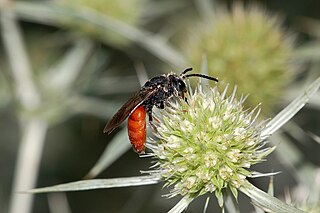 W
WSphecodes albilabris is a solitary parasitic bee that is endemic to Central and Western Europe. The larvae of this species are parasites of Colletes cunicularius.
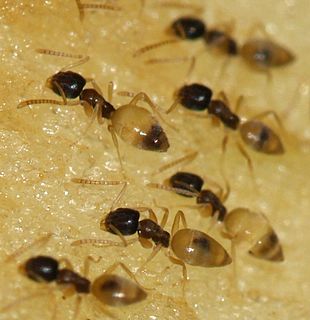 W
WTapinoma melanocephalum is a species of ant that goes by the common name ghost ant. They are recognised by their dark head and pale or translucent legs and gaster (abdomen). This colouring makes this tiny ant seem even smaller.
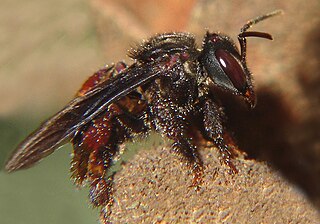 W
WTrigona spinipes is a species of stingless bee. It occurs in Brazil, where it is called arapuá, aripuá, irapuá, japurá or abelha-cachorro ("dog-bee"). The species name means "spiny feet" in Latin. Trigona spinipes builds its nest on trees, out of mud, resin, wax, and assorted debris, including dung. Therefore, its honey is not fit for consumption, even though it is reputed to be of good quality by itself, and is used in folk medicine. Colonies may have from 5,000 to over 100,000 workers.
 W
WTylopsis lilifolia, the lily bush-cricket, is a species of katydid in the subfamily Phaneropterinae. It is found in Europe and Asia.
 W
WVespula germanica is a species of wasp found in much of the Northern Hemisphere, native to Europe, Northern Africa, and temperate Asia. It has spread and become well-established in many other places, including North America, South America, Australia, and New Zealand. German wasps are part of the family Vespidae and are sometimes mistakenly referred to as paper wasps because they build grey paper nests, although strictly speaking, paper wasps are part of the subfamily Polistinae. In North America, they are also known as yellowjackets.
 W
WXenos vesparum is an insect species, whose females are permanent entomophagous endoparasites of Polistes paper wasps. They dwell their entire lifespan in the abdomen of the wasp. Two particular species of social wasp it has been known to infect are Polistes gallicus and Polistes dominula. Younger members of a wasp colony tend to be targeted, although X. vesparum displays parasitic behavior in all stages of this host.
 W
WXorides praecatorius is a parasitoid wasp from ichneumonid family that parasitizes many long-horned beetles of the following species: Tetropium castaneum, Tetropium fuscum, Aromia moschata, Callidium aeneum Callidium violaceum, and some other.